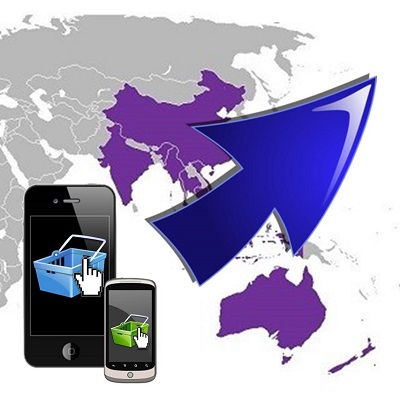Shoppers throughout the 13 nations that make up the Asia Pacific marketplace use smartphones more regularly.
According to the results of a recent survey that was conducted by Visa, consumers throughout the 13 countries that make up the APAC marketplace have claimed that they have been using mobile shopping to make purchases at a considerably greater rate than ever before.
In fact, the survey results showed that the gap between e- and m-commerce is notably shrinking.
The survey compared the use of mobile shopping this year over what it was in 2014, and it determined that the market had experienced an increase of 22 percent among consumers in Asia Pacific countries. Moreover, the research also determined that there are now more consumers in that region of the world who are paying their bills and who are making product purchases by way of smartphones and desktops than there are those who make those same transactions over desktop computers.
The mobile shopping figures were published within the 2015 Regional E-commerce Monitor Survey from Visa.
 The countries in the APAC region that experienced the largest amount of growth were Indonesia, China and Taiwan. They saw a growth of m-commerce use of 36, 34 and 28 percent, respectively. These figures were based on the responses that were given by 11,760 respondents who reside throughout the 13 different Asia Pacific nations. Also among those countries are Vietnam, India, Australia, Singapore and Malaysia.
The countries in the APAC region that experienced the largest amount of growth were Indonesia, China and Taiwan. They saw a growth of m-commerce use of 36, 34 and 28 percent, respectively. These figures were based on the responses that were given by 11,760 respondents who reside throughout the 13 different Asia Pacific nations. Also among those countries are Vietnam, India, Australia, Singapore and Malaysia.
The Visa survey found that consumers in Thailand were equally as likely to make a purchase over a mobile device as they were over a laptop or desktop computer. The report on the research also indicated that the gap between the use of mobile and desktop computers for commerce was decreasing in several countries including South Korea, China and Indonesia.
According to Conor Lynch, the director of regional e-commerce at Visa, the findings of the survey have revealed a rising “norm” in making purchase through mobile shopping channels. “As consumers get more comfortable using their smart devices to research, browse, and purchase, m-commerce should soon overtake traditional e-commerce habits, strengthening this channel of engagement between consumers and retailers,” he said.
Some of the giants in the industry are saying that smartphone shopping will soon be far more personalized.
As mobile commerce continues its evolution, new developments, insights, and predictions have become relatively commonplace, particularly as a growing number of real-life features are starting to be included in the shopping experience to integrate smartphones in the shopping experience.
Beacons, mobile marketing, and smartphone based payments at checkout counters are blurring the reality/digital lines.
Now, some of the largest players in this market, including Google, Facebook, and Foursquare, are attempting to ensure that smartphone users are able to use mobile commerce to purchase the products and services they want whenever they want them and at any time. This effort is also trying to make the process as seamless as possible. These companies have also revealed that there is one major trend that appears to be present on virtually every level of mobile commerce as it moves ahead, and that is customization and personalization. The more a customer is able to see relevance and convenience with the use of smartphones as a part of their shopping experience, the more they are using it.
Mobile commerce is, therefore, about to become an increasingly personalized experience for consumers.
 According to the Facebook director of global marketing solutions, Kelly Graziadei, mobile apps are making up about half the total time that consumers are spending on their smartphones and tablets. Moreover, it was pointed out that 75 percent of that time is spent on the four most popular mobile apps, including that social network.
According to the Facebook director of global marketing solutions, Kelly Graziadei, mobile apps are making up about half the total time that consumers are spending on their smartphones and tablets. Moreover, it was pointed out that 75 percent of that time is spent on the four most popular mobile apps, including that social network.
Therefore, among the main questions that are now being asked by the companies behind the leading applications is with regards to how they can go about continuing to engage a customer over the application and ensure that the right product is placed in front of the right individuals at exactly the time that they actually want it.
Graziadie explained that deep linking makes it possible for a customer to be sent from their Facebook or Instagram account to a retailer, and while this is a “big part of it,” it is also important to note that one of the primary questions in retail is exactly where the customer should be sent. Should it be to an app or to the website. The next mobile commerce question is how to use that direction to ensure that the experience will be as seamless as possible, as the key is to make sure that it is an entirely personalized experience.
 The countries in the APAC region that experienced the largest amount of growth were Indonesia, China and Taiwan. They saw a growth of m-commerce use of 36, 34 and 28 percent, respectively. These figures were based on the responses that were given by 11,760 respondents who reside throughout the 13 different Asia Pacific nations. Also among those countries are Vietnam, India, Australia, Singapore and Malaysia.
The countries in the APAC region that experienced the largest amount of growth were Indonesia, China and Taiwan. They saw a growth of m-commerce use of 36, 34 and 28 percent, respectively. These figures were based on the responses that were given by 11,760 respondents who reside throughout the 13 different Asia Pacific nations. Also among those countries are Vietnam, India, Australia, Singapore and Malaysia.
 According to the Facebook director of global marketing solutions, Kelly Graziadei, mobile apps are making up about half the total time that consumers are spending on their smartphones and tablets. Moreover, it was pointed out that 75 percent of that time is spent on the four most popular
According to the Facebook director of global marketing solutions, Kelly Graziadei, mobile apps are making up about half the total time that consumers are spending on their smartphones and tablets. Moreover, it was pointed out that 75 percent of that time is spent on the four most popular 